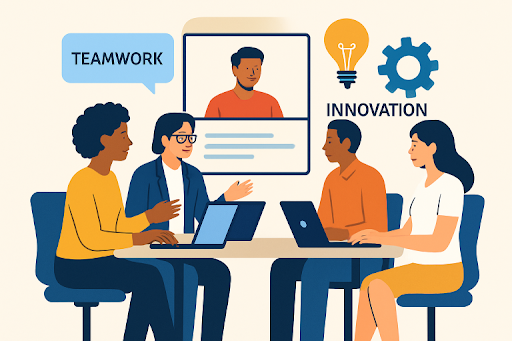Key Takeaways
- Gamification bridges motivation gaps and makes collaboration engaging.
- Immersive VR activities foster meaningful team bonding, especially for remote teams.
- Cross-functional projects break down communication silos and encourage fresh perspectives.
- Design thinking nurtures creative problem-solving and user-focused innovation.
- Employee Resource Groups (ERGs) enhance inclusion and shared purpose.
- Innovation challenges and hackathons encourage teamwork and creative excellence.
In the era of remote collaboration, hybrid offices, and ongoing digital transformation, effective team building has evolved beyond traditional icebreakers and annual retreats. Organizations now seek ways to foster deep trust, share goals, and unlock innovative potential in their teams. A rapidly expanding trend is the integration of technology and psychological insights—such as pre-employment testing—to design better engagements that boost morale, transparency, and cooperation. Organizations that succeed at creative team building not only excel operationally but tend to attract and retain the best talent in an increasingly competitive marketplace.
Traditional activities, such as trust falls or ropes courses, no longer deliver substantial value. In contrast, a strategy centered on modern, tailored, and engaging experiences actively strengthens team bonds and is better aligned with today’s work realities. Forward-thinking organizations understand that fostering genuine collaboration means adopting fresh tactics that resonate with their teams’ daily lives, skills, and aspirations.
By leveraging innovative practices—ranging from gamification and virtual reality to structured cross-functional initiatives—leaders tap into new ways to engage every voice and every strength. Combined with empathy-driven approaches and community-building Employee Resource Groups (ERGs), creative team-building efforts move the needle on inclusion, innovation, and productivity.
Modern organizations embracing these strategies report stronger engagement scores and increased employee satisfaction, setting themselves apart in sectors where adaptability and cohesion are invaluable assets.

Gamification: Turning Team Building into a Game
Gamification applies well-established game mechanics—such as points, badges, and leaderboards—to everyday teamwork, turning routine activities into dynamic, collaborative experiences. Organizations report that introducing gamified systems heightens motivation, increases participation, and clarifies group goals. Whether through digital apps or custom-designed programs, gamification taps into innate competitiveness and rewards progress, helping teams celebrate milestones together and build resilience through healthy competition.
For example, collaborative games that align with company goals—such as sales sprints, code-a-thons, or creative challenges—create a sense of camaraderie and investment in shared success. According to recent research from Forbes, companies using gamification have seen up to a 50% improvement in engagement rates, highlighting its power as an ongoing motivational driver.
Virtual Reality Team Bonding Activities
Virtual reality has evolved from a novelty to an essential tool in the era of remote work. VR enables geographically dispersed teams to work together in realistic, interactive environments, breaking down geographic barriers and fostering deep connections. Activities such as virtual escape rooms, digital whiteboard brainstorming, and immersive team quests foster trust, hone collaborative problem-solving skills, and enable teams to practice communication in low-stakes, high-engagement settings.
Organizations experimenting with VR find that it builds empathy and rapport, especially in teams that rarely meet face-to-face. Industry-wide reports, such as those from Gartner, predict that virtual workspaces will soon become a staple for forward-thinking organizations, providing a competitive edge in employee engagement and retention.
Cross-Functional Collaboration Initiatives
Innovation tends to thrive at the intersection of diverse skill sets, backgrounds, and ideas. Cross-functional collaboration initiatives bring together talent from diverse areas, such as engineering, marketing, operations, finance, and others, to tackle specific projects or ongoing challenges. These interdisciplinary teams combine technical knowledge with creative insight, breaking down departmental silos and sparking groundbreaking innovation.
Best practices for such initiatives include rotating leadership roles, setting clear but flexible objectives, and fostering open dialogue. Harvard Business Review notes that sustained cross-functional collaboration can drive better decision-making and cultivate a more inclusive organizational culture, ultimately sharpening a company’s competitive advantage.
Design Thinking Workshops
Design thinking workshops anchor team building in empathy, experimentation, and iterative learning. The methodology starts with deep user research, guiding teams through stages of brainstorming, prototyping, and testing solutions. By engaging in these hands-on workshops, organizations help team members view challenges through a human lens, encouraging both empathy for end-users and mutual support among colleagues.
This approach not only sparks innovative ideas but also fosters psychological safety, enabling every participant to feel heard and valued. Leading organizations credit design thinking with streamlining workflows, accelerating time-to-market, and building collaborative skills that extend well beyond the workshop setting.
Employee Resource Groups (ERGs)
Employee Resource Groups are powerful vehicles for inclusion, connection, and engagement. As voluntary and employee-led, ERGs unite individuals around shared affinities—be it cultural background, professional interests, or advocacy for specific causes. These groups offer opportunities for dialogue, networking, mentorship, and professional development, thereby extending the benefits of team building to foster lasting connections across all levels of an organization.
Companies leveraging ERGs see measurable gains in employee satisfaction and retention, especially among underrepresented groups. ERGs can catalyze culture change, inform organizational policies, and deepen collective resilience during periods of transformation or uncertainty.
Innovation Challenges and Hackathons
Innovation challenges—including hackathons—are structured competitions that invite employees to solve pressing business problems in creative, time-bound sprints. These events encourage collaboration under pressure, empowering teams to experiment, take calculated risks, and showcase new ideas. Participants not only sharpen their technical and creative skills but also build lasting professional bonds by overcoming shared obstacles.
Successful companies regularly host hackathons to identify new opportunities, develop innovative products, and foster grassroots innovation. According to Inc., such events inject fresh energy into teams and management alike, fostering a sense of accomplishment and community.
Conclusion
Creative team building is the cornerstone of future-ready organizations—those agile enough to evolve, inclusive enough to thrive, and innovative enough to lead in a rapidly changing world. By embracing strategies such as gamification, virtual reality, cross-functional collaboration, design thinking, ERGs, and innovation challenges, organizations lay the groundwork for authentic engagement and breakthrough results. The benefits ripple through every facet of the business, cultivating a stronger, more collaborative, and resilient workforce that’s equipped to meet tomorrow’s challenges head on.



